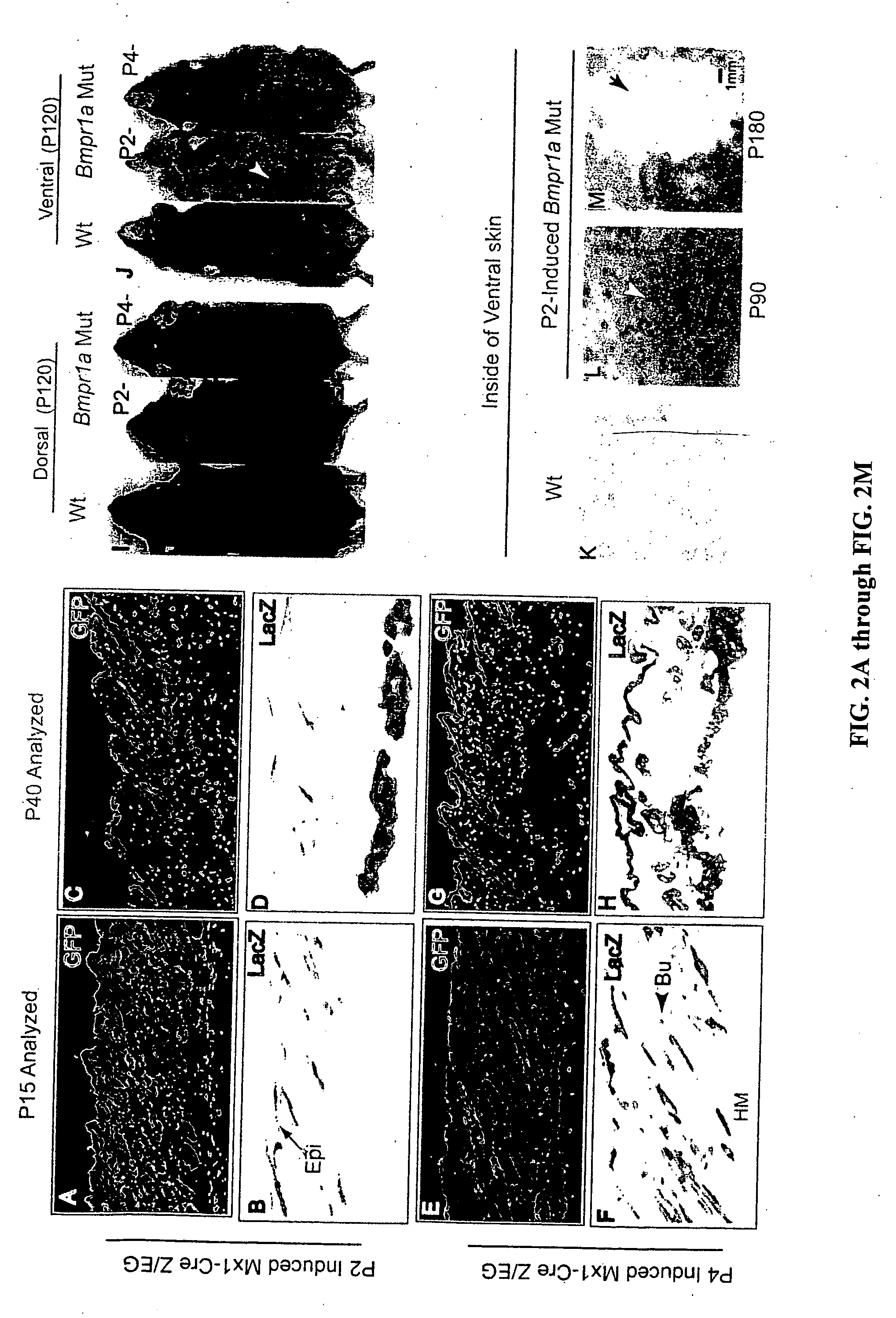Methods and compositions for controlling hair follicle stem cell fate
a technology of stem cell fate and composition, which is applied in the field of methods and compositions for controlling hair follicle stem cell fate, can solve the problems of imposing limitations on the use of stem cells in transplantation, lack of in vivo information regarding the regulatory signal mechanism, and hfsc population numbers increase, so as to promote the growth of hfsc population and increase the number of hair follicle stem cells
- Summary
- Abstract
- Description
- Claims
- Application Information
AI Technical Summary
Benefits of technology
Problems solved by technology
Method used
Image
Examples
example 1
[0245] An inducible pre-excision Bmpr1a knockout mouse was generated to enable characterization of the effect of Bmpr1a gene deletion upon hair follicle stem cell (HFSC) proliferation, differentiation, and tumorigenesis. The conditional knockout Bmpr1a mouse was obtained by crossing a Bmpr1afx / fx mouse line with an interferon-inducible Mx1-Cre mouse line. A heterozygous Bmpr1a± mouse was also used to generate a Bmpr1afx / − mouse as a control.
[0246] The Bmpr1afx / fx mouse line was obtained by targeting vector-mediated insertion of LoxP sites into the Bmpr1a locus of mouse embryonic stem (ES) cells. One LoxP site was placed in intron 1 of the Bmpr1a gene, and two other flanking LoxP sites were located in an EcoRI site in intron 2 surrounding a PGK-neo expression cassette. The PGK-neo expression cassette introduced Bg / I and EcoRV restriction sites into the wild type Bmpr1a gene, and the cassette was inserted in reverse orientation relative to the direction of Bmpr1 transcription between...
example 2
[0249] The pre-excision Mx1-Cre+Bmpr1afx / fx mutant mouse obtained in the previous example was injected postnatally with PolyI:C, a recombination activator, to induce excision of Exon2 of the Bmpr1a gene. The Bmpr1a locus was successfully targeted for excision by three injections of the PolyI:C recombination activator at two-day intervals, as demonstrated by PCR results obtained three months after birth. Thus, it was determined that a post-excision Mx1-Cre+Bmpr1afx / fx mutant mouse resulted that possessed mutant Bmpr1a genes encoding inactive and truncated Bmpr1a receptor polypeptide.
[0250] Mx1-Cre Bmpr1a mutant pups were injected intraperitoneally (I.P.) with PolyI:C (Sigma-Aldrich, St. Louis, Mo., P-0913, 250 μg / dose) at indicated time points (3 times daily, on alternate days) to induce Cre-mediated LoxP recombination. Pups were randomly divided into two groups as follows: In the first group, the pups were injected with PolyI:C at P 2, 4, 6 injection time points. In the second grou...
example 3
[0251] The efficiency of the murine Mx1-Cre line in mediating LoxP-dependent DNA excision in the Bmpr1a gene in hair follicles (HFs) was determined by using a murine hybrid cross between the previously described Bmpr1a Mx1-Cre knockout mouse and a ZIEG reporter mouse. The hybrid mouse was selected because it permitted assessment of the extent of recombination occurring following administration of the recombination activator PolyI:C described in example 2 above.
[0252] The Z / EG reporter mouse was made by introduction of a Z / EG expression vector into R1 ES cells utilizing standard genetic engineering technology. This mouse was designated as “Z / EG” because it expressed both LacZ and enhanced green protein (GFP) reporters. This Z / EG double reporter mouse initially expressed the LacZ gene that encodes the β-galactosidase enzyme, driven by a ubiquitously active promoter, throughout embryonic and adult stages.
[0253] In the hybrid Mx1-Cre Z / EG reporter mouse, the LacZ indicator gene was fl...
PUM
| Property | Measurement | Unit |
|---|---|---|
| Electrical resistance | aaaaa | aaaaa |
| Nucleic acid sequence | aaaaa | aaaaa |
| Fluorescence | aaaaa | aaaaa |
Abstract
Description
Claims
Application Information
 Login to View More
Login to View More - Generate Ideas
- Intellectual Property
- Life Sciences
- Materials
- Tech Scout
- Unparalleled Data Quality
- Higher Quality Content
- 60% Fewer Hallucinations
Browse by: Latest US Patents, China's latest patents, Technical Efficacy Thesaurus, Application Domain, Technology Topic, Popular Technical Reports.
© 2025 PatSnap. All rights reserved.Legal|Privacy policy|Modern Slavery Act Transparency Statement|Sitemap|About US| Contact US: help@patsnap.com



